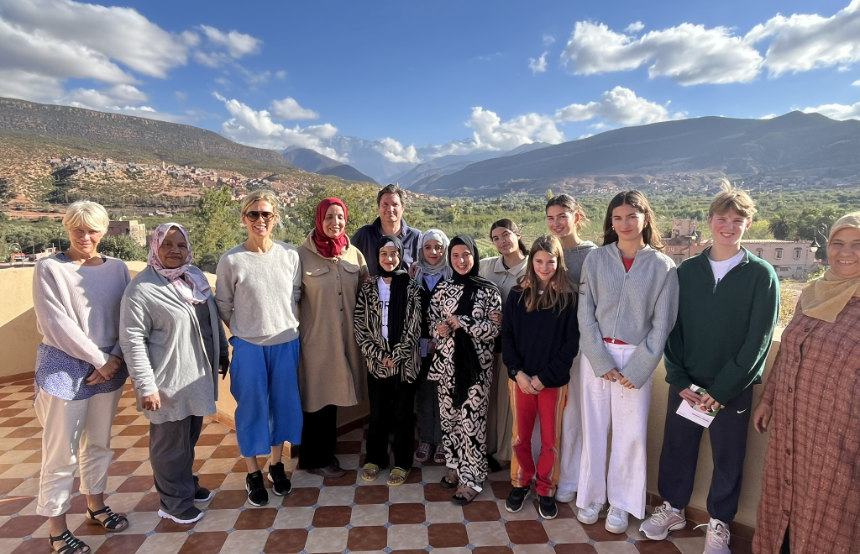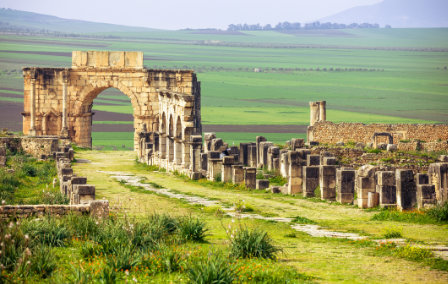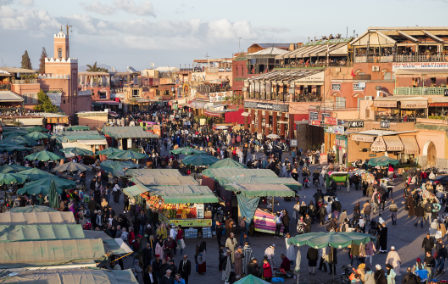Published 1st May. 2024
Reading time
Enjoying year-round sunshine, a holiday in Morocco is always a good idea, no matter the month. This North African nation has everything from mystical mountains and a wild coastline to bustling souqs and medina mazes. But Morocco’s marvels are no secret. Seeing a 20% year-on-year increase in tourism revenue, which reached a staggering $10.5 billion in 2023, it’s clear that tourism in Morocco is only heading in one direction. How can we, as tourists, help alleviate the adverse effects? To learn how to enjoy a climate-conscious trip and copious cups of guilt-free mint tea, read our guide to sustainable tourism in Morocco…
1. Undertourism in Morocco
2. Philantourism in Morocco
3. Community-based tourism in Morocco
4. Indigenous tourism in Morocco
5. Flight-free travel in Morocco
Mass tourism is an increasingly challenging problem to solve. Morocco is no stranger to its positive and negative impacts, receiving an influx of over 14 million tourists in 2023. The solution? Transforming overtourism into Undertourism - promoting travel to under-the-radar spots - is crucial to sustainable tourism in Morocco. Swap Marrakech for ‘mini Marrakech’, the town of Taroudant, nestled in the Souss Valley. Frequented by far fewer tourists, this southern trading centre has enough lively souqs, tantalising trinkets and ancient ramparts to rival any popular Moroccan city. Nature lovers? Stray from the tourist trail and hike in the rugged Ameln Valley in the Anti-Atlas Mountains, or visit the coastal Al Hoceima National Park for an array of wildlife and unspoilt beauty spots. Beach bums, swap popular Essaouira for the laid-back coastal town of Oualidia to enjoy quiet stretches of sand and sensational seafood.
The 6.8 magnitude earthquake that hit Morocco in September 2023 was a heartbreaking reminder of nature’s unpredictability. With its epicentre in the High Atlas Mountains, the earthquake caused severe destruction in Marrakech and nearby mountain communities, destroying homes and killing more than 2,900 people. Understandably, natural disasters such as these can leave us feeling helpless. But there’s a simple way we can help. This is where our concept of Philantourism comes in: the act of choosing a destination that stands to benefit the most from tourism. Purely by visiting places affected by the earthquake in Morocco, tourists contribute to the local economy and help people rebuild their livelihoods. Staying in locally run homestays, dining in local restaurants, and buying as many handcrafted goods as your luggage allows, are just some of the ways to aid the area’s recovery.

Image by Birgit Sfat
Sustainable tourism in Morocco is all about getting involved in community-based activities. This means opting for experiences led by local guides, such as a naturalist-led bird-watching walk through the Wadi Massa National Park or an educational walking tour around Fez’s medina (the oldest active medina in the world). With the knowledge of a local, receive insider tips and discover hidden gems off the well-trodden route - all while supporting communities. To get tastebuds tingling, learn to perfect Moroccan flavours and spices in a community-led cookery class in the Atlas Mountains (tagine is on the menu). Make sure to steer clear of tourist-trap chain hotels, too, and choose to stay in locally-run accommodation instead. This way, you’ll simultaneously experience a more authentic Morocco and contribute to local incomes.
Championing indigenous culture, traditions and ways of life is key to sustainable tourism in Morocco. The Amazigh (or Berber) people have a population of around 30 to 40 million scattered across North Africa. Most live in Morocco and Algeria, where they speak their own language, Tamazight, in several dialects. Head to the region of Souss-Massa (the Amazigh heartland) and stay in Tafraout and Taroudant, nestled in the Anti-Atlas Mountains. Embark on trekking tours led by the Amazigh and purchase Amazigh-made crafts (including pottery and textile art). Another way to responsibly experience and support Amazigh culture is to visit one of their vibrant festivals, such as the Imilchil Marriage Festival or the Almond Blossom Festival. In the north, traverse mountains to remote Amazigh villages dotted around the High Atlas Mountains and the Agafay Desert (all with the help of an indigenous guide, of course).

Image by Jackie Cole
Handily for flight-free fans, Spain lies a mere eight miles across the water from Morocco at its shortest point. The most popular ferry route is from Tarifa to Tangier, which takes just over an hour, although ferries also depart from Barcelona, Algeciras, Malaga and the British territory of Gibraltar. For bonus sustainability points, catch trains all the way from the UK to southern Spain, or (the slightly less eco option) drive and bring your car on the ferry so you can embark on an epic road trip across Morocco. If time is on your side, why not combine tapas tours with tagine tastings and sample the best of both countries? Forgoing flights is one of the easiest ways to practice sustainable tourism in Morocco. And once you arrive in the North African nation, travelling by train or car is the most efficient way to get around. Boasting a rail network that travels to tourist destinations including Fez, Marrakech, Casablanca, Rabat and Tangier, you can forget the faff of domestic flights.
Written by Hannah Whitehall | Header image by Birgit Sfat

As regular visitors to Morocco, we know our riads from our kasbahs and our tagines from our hariras. Whether travelling as a family or a couple, our consultants know the best accommodation options for you and can plan everything from intimate picnics in the Agafay Desert to authentic interactions with Berber families. Forget about the stress of moving from A to B, as we have first-hand experience with Moroccan rail and roads and can tailor your itinerary around their nuances. Our in-country Concierges even have restaurant recommendations galore; their advice is just a WhatsApp away.
ENQUIRE NOWPractical advice and inspiration for your next trip

We believe travel should positively impact the destinations we visit, which is why our Foundation supports projects like Education For All (EFA) in Morocco. EFA is dedicated to tackling high illiteracy rates among women and girls in Morocco’s rural regions. The non-profit organisation funds boarding houses that enable teenage girls from remote villages in the Atlas Mountains to continue their secondary education.
25th November 2025 - Morocco

Any trip to Fes should include a day out to the Roman ruins of Volubilis, probably the largest and best-preserved ruins in Morocco. With scenery reminiscent of Russell Crowe’s homecoming in ‘Gladiator’ (more for the surrounding countryside than for the grisly welcome he got), Volubilis is a must-see for history buffs and lovers of picturesque vistas alike. Find out why you should visit in our Volubilis guide… 1.
23rd April 2025 - Morocco Culture

Marrakech is undoubtedly one of the ultimate city break destinations. Where else is filled with so much exoticism and mystery and yet can be reached in less than four hours from the UK? Picture this: you're slowly making your way through the sprawling labyrinthine alleys that make up Marrakech's famous souq, all hope of finding your way back seems lost, but it doesn’t matter because you’re too absorbed in soaking up everything around you.
4th March 2025 - Morocco 24 Hours In

Our team of destination experts will get to know you and your unique requirements for your holiday

We work with you to build an ultra-personalised holiday itinerary with your choice of accommodation, experiences and activities

All of our holidays include little extras designed to make a big difference to your trip, from fast-tracking you through airport check-in and security to our network of local Concierges